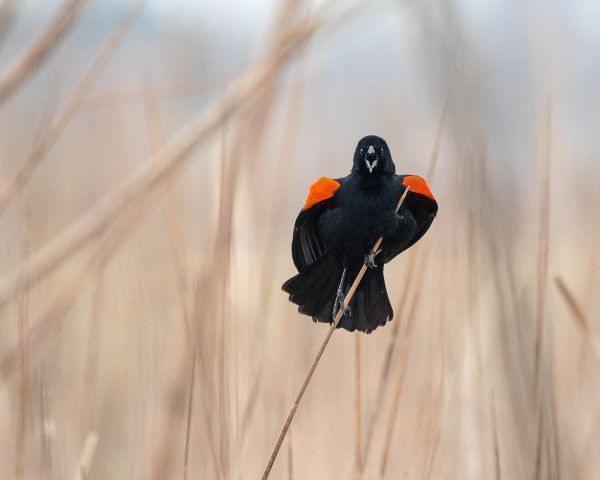A month of welcome changes

Before the end of the month, red-winged blackbirds will begin staking out territorites. Rob Kanter
The more I get outside in February, the more I’m reminded what a month of change it is. Last weekend I as I walked my dogs near home, I noticed that not only were the cardinals and Carolina wrens singing, but that house finches were tuning up as well. House finches have far less power in their voices than cardinals or wrens, but, to me, their persistent, wandering song accentuates whatever warmth there is on a sunny winter day.
Later, as I ran through Meadowbrook Park with a friend, we even heard a song sparrow sing—just once, but enough to count as a first-of-year in my mental birding notes.
Funny that over the same weekend I also spent some time on the birds of winter central Illinois. Another friend and I drove country roads in Piatt County searching for a snowy owl that had been reported days before but found only the other birds common in open-country at this time of year: American kestrels hunting from power lines, a northern harrier coursing over a barren field, horned larks and Lapland longspurs taking advantage of exposed soil where the snow had melted beside the road.
Within the next few weeks, some of our early bird migrants will also be returning. Keep an eye on places where cattails grow for the year’s first red-winged blackbirds. Unlike robins, which in recent decades have begun to stay with us through winter, red-winged blackbirds still fly south. As they come back to claim breeding territories in late February, they are true harbingers of spring in central Illinois.
Birders who are itching for activity have some good opportunities this month. The Great Backyard Bird Count, sponsored by the Cornell Lab of Ornithology and the National Audubon Society, runs from February 15th through the 18th. This event encourages people to record their observations of birds over the three-day period according to a simple set of guidelines, and then submit them via the Web.
You can participate in the Great Backyard Bird Count at home or in the company of other people. The Champaign County Audubon Society will be counting birds at the Anita Purves Nature Center in Urbana on Saturday, February 16th, from 9:00 a.m. until 4:00 p.m., with guided hikes at 10:00 a.m. and 3:00 p.m.
Absent truly unusual weather, the next four weeks will see the ice that still covers our ponds and wetlands retreat. As it does, amphibians will congregate to breed—more salamanders, toads and frogs than you would ever imagine if you’ve not gone out on a rainy March night to see and hear for yourself. Think of it, wood frogs, chorus frogs and spring peepers, which may be partly frozen in the mud now, will be singing their hearts out before you know it.
Whether or not the thaw that began this week continues, the first flower of spring, skunk cabbage, will emerge in woodland seeps by the end of the month, thanks to its capacity to generate heat and grow through frozen soil. I realize that few people will go out of their way to see it, but doesn’t it do you good just to know that something will be growing soon?

